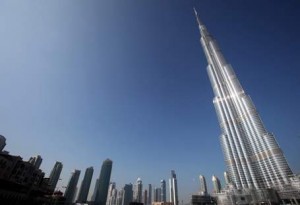Source: www.thenational.ae
One man’s attempt to link the Burj Khalifa’s height with a pioneer of German Romanticism.

“Still it is day. Up man, to work once more!” So wrote Johann Wolfgang von Goethe in West-Eastern Divan, a collection of lyrical poems published in 1819, when he was 70 years old. It was advice that Goethe had taken to heart on most days of his life; how else could he have edited several literary magazines; worked as a lawyer; learned Greek, Latin, French and English; participated in a failed German invasion of revolutionary France; written what was arguably the world’s first literary best-seller, The Sorrows of Young Werther; published thoughts on evolution that were later cited approvingly by Charles Darwin; penned Faust, surely one of the most famous plays ever; developed an influential theory of colour; minted the concept of “world literature”; and invented his own sort of barometer?
In the nearly 178 years since his death, Goethe has been widely cited as a massive influence on well, everything – from the philosophy of science to Romantic literature to the way westerners celebrate Christmas. Last week, as news of the completed Burj Khalifa spread across the world, a small but heated debate raged as to whether the German polymath also deserved some recognition for a small role in the world’s latest piece of ambition incarnate.
Late on the evening of January 4, a Wikipedia user with the handle “Rbbloom” made a two-line addition to the “Current records” section of the online encyclopedia’s Burj Khalifa entry. According to Rbbloom, not only is the tower the tallest ever built, not only does it contain the world’s speediest elevators, not only did its construction involve the highest vertical concrete pumping in history: it is also the only tower in the world whose height in metres – 828 – is the same as the numerical month-date representation of Goethe’s August 28 birthday: 8/28.
Two minutes later, another user by the name of “Timsdad” deleted Rbbloom’s additions, describing it as “random trivia”. The next day, Rbbloom noticed the deletion, and took to the entry’s behind-the-scenes discussion section to vent his frustration. “Does anyone think the 828 metre height was accidentally arrived at?” he wondered. “I don’t. It’s Goethe’s birthday and Goethe is supposed to have had the ‘highest’ IQ ever achieved. Isn’t this a relevant fact to include?”
If any memebers of the small cadre of Wikipedia users dedicated to the accuracy of the Burj Khalifa page found this compelling, they kept it to themselves. The objections voiced were many: dates in Dubai are written date-month, not month-date; none of the project’s many architects have ever mentioned Goethe publicly; it seems more likely – as reported on The National’s “Crane Country” blog – that any numerological significance of the height was derived from an interest on the part of the Emaar CEO Mohammed Alabbar in Chinese feng shui, which looks kindly on the number eight.
But Rbbloom, who soon began signing his comments “Richard Barnett ‘Dick’ Bloom”, was nonplussed. Goethe, he pointed out, was a revolutionary, the first modern man. Goethe, he asserted, literally invented modern psychology. Given the scope of Goethe’s influence, he theorised, it wouldn’t be surprising if the tower’s planners referenced his birthday without even knowing it. Bloom also saw fit to note that he scored very well on the SATs, an aptitude test used in American university admissions, despite being “half deaf at the time”; he is, he wrote, sure he would achieve a perfect score if he took it again.
A few moments of online sniffing indicated that, whoever Bloom was, he had edited Wikipedia articles on several old US Navy ships, cardiac electrophysiology, the 1922 Broadway novelty song Yes! We Have no Bananas, the Bloom Brothers Department Stores that operated in the American state of Pennsylvania between 1897 and 1944, Emily Dickinson, Harry S Truman, and Harvard University’s Quincy House, to name a few. A few more minutes and a handful of succesful inferences turned up a probable email address, and an email led to a phone conversation.
“I’ve been reading Goethe since I was a teenager,” Bloom explained. “And I studied him at Harvard. I’ve read everything he ever wrote in the original German. I’m no expert, but I’m a fan.
“The fact is that the building is as tall as Goethe was intelligent, and any literate writing about the building should mention this, whether the architect was conscious of it or not. A building like this could bring some new attention to Goethe, encourage them to take a new look at his life. Then his IQ will work for all of us.”
In the meantime, Wikipedia’s discussion of how to address the Burj Khalifa moved on to other questions: How many, if any, of the building’s storeys are usable only for storage? What is the height of the roof, as opposed to the spire? How many people died or suffered injuries during its construction? Stylistic and substantive changes from a few dozen enthusiasts trickled in all week.
As of press time, not every lingering inquiry had been answered – far from it – but the article is pretty decent, and a good deal more informative than most newspaper articles on the same subject. As is sometimes the case, a Goethe quote seems apt: “Whatever we may say against collections, which present authors in a disjoined form, they nevertheless bring about many excellent results.”
Peter C Baker












